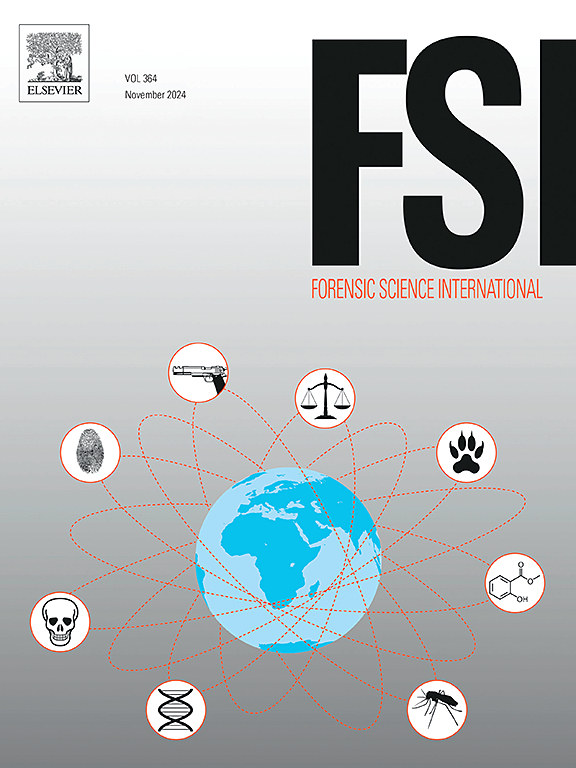唇前牙列的3D - 3D注册:一种潜在的在世个体个人识别方法
IF 2.2
3区 医学
Q1 MEDICINE, LEGAL
引用次数: 0
摘要
3D视频监控和牙齿重建的最新进展使3D唇前牙列模型的预采集成为可能,当面部障碍阻碍传统方法时,为法医齿科医生提供关键数据进行识别。然而,之前没有研究证实3D-3D注册在牙齿识别中独家使用唇前牙列特征的可靠性。本研究提出了一种3D-3D唇牙列注册方案,并系统地评估了其在两种精度场景下的法医功效:高精度(口腔内扫描)和低精度(3D面部扫描)。30名参与者接受了上颌口内扫描(IOS-1)和3D面部模型(Face-1)的连续采集,并在间隔6个月后获得后续采集(IOS-2, Face-2)以评估时间一致性。使用Geomagic Control X软件进行唇冠感兴趣区域(roi)的标准化提取,随后计算匹配和不匹配对之间的均方根(RMS)距离。采用相对技术测量误差(rTEM)和Mann-Whitney U检验来评估观察者误差和组差异。在高精度场景下,观察者内部和观察者之间的rTEM值为<; 4.85 %,匹配值(RMS: 0.07-0.19 mm)显著低于不匹配值(0.45-1.62 mm);P <; 0.001),无重叠。受试者工作特征(ROC)分析在0.32 mm截止点上达到100% %的准确度。在低精度场景下,rTEM值为<; 8.21 %,匹配值(0.26-0.63 mm)显著低于不匹配值(0.50-1.89 mm);P <; 0.001),但部分重叠。在0.63 mm处,ROC分析的灵敏度为96.3% %,特异性为100 %(准确率为99.7 %)。高精度模型显示出优越的鉴别能力。该研究建立了活体个体识别中唇牙3D-3D注册的技术有效性,高精度模型展示了法医级的鉴别能力。这种方法解决了当代法医实践中传统面部识别受到数据限制的关键挑战。本文章由计算机程序翻译,如有差异,请以英文原文为准。
3D‑3D registration of labial anterior dentition: A potential method for personal identification in living individuals
Recent advancements in 3D video surveillance and dental reconstruction enable pre-acquisition of 3D labial anterior dentition models, offering forensic odontologists critical data for identification when facial obstructions impede traditional methods. However, no prior studies have validated the reliability of 3D-3D registration for exclusive use of labial anterior dentition features in dental identification. This study proposes a protocol for 3D-3D registration of labial dentition and systematically evaluates its forensic efficacy across two precision scenarios: high- (intraoral scans) and low-precision (3D facial scans). Thirty participants underwent sequential acquisition of maxillary intraoral scans (IOS-1) and 3D facial models (Face-1), with follow-up acquisitions (IOS-2, Face-2) obtained after a six-month interval to assess temporal consistency. Standardized extraction of labial crown regions of interest (ROIs) was performed using Geomagic Control X software, with subsequent calculation of root mean square (RMS) distances between matched and mismatched pairs. Relative Technical Error of Measurement (rTEM) and Mann-Whitney U tests were used to assess observer errors and group differences. In the high-precision scenario, intra- and inter-observer rTEM values were < 4.85 %, with matches (RMS: 0.07–0.19 mm) significantly lower than mismatches (0.45–1.62 mm; P < 0.001), showing no overlap. Receiver Operating Characteristic (ROC) analysis achieved 100 % accuracy at a 0.32 mm cutoff. In the low-precision scenario, rTEM values were < 8.21 %, with matches (0.26–0.63 mm) significantly lower than mismatches (0.50–1.89 mm; P < 0.001) but partial overlap. ROC analysis yielded 96.3 % sensitivity, 100 % specificity (99.7 % accuracy) at 0.63 mm. High-precision models demonstrated superior discriminatory power. The study establishes technical validity for labial dentition 3D-3D registration in living individual identification, with high-precision models demonstrating forensic-grade discriminative capability. This approach addresses critical challenges in contemporary forensic practice where conventional facial recognition is impeded by data limitations.
求助全文
通过发布文献求助,成功后即可免费获取论文全文。
去求助
来源期刊

Forensic science international
医学-医学:法
CiteScore
5.00
自引率
9.10%
发文量
285
审稿时长
49 days
期刊介绍:
Forensic Science International is the flagship journal in the prestigious Forensic Science International family, publishing the most innovative, cutting-edge, and influential contributions across the forensic sciences. Fields include: forensic pathology and histochemistry, chemistry, biochemistry and toxicology, biology, serology, odontology, psychiatry, anthropology, digital forensics, the physical sciences, firearms, and document examination, as well as investigations of value to public health in its broadest sense, and the important marginal area where science and medicine interact with the law.
The journal publishes:
Case Reports
Commentaries
Letters to the Editor
Original Research Papers (Regular Papers)
Rapid Communications
Review Articles
Technical Notes.
 求助内容:
求助内容: 应助结果提醒方式:
应助结果提醒方式:


